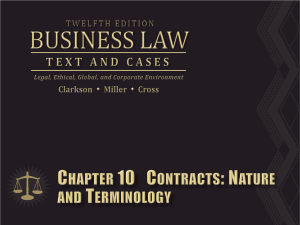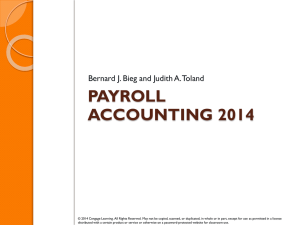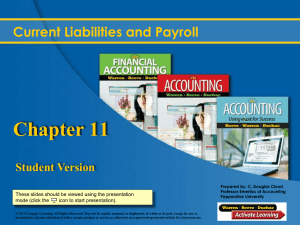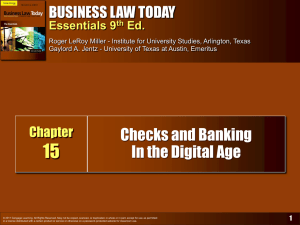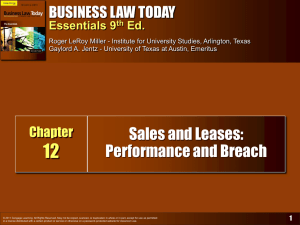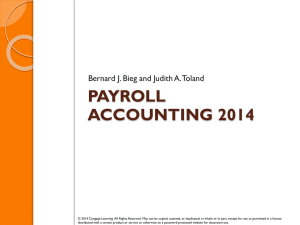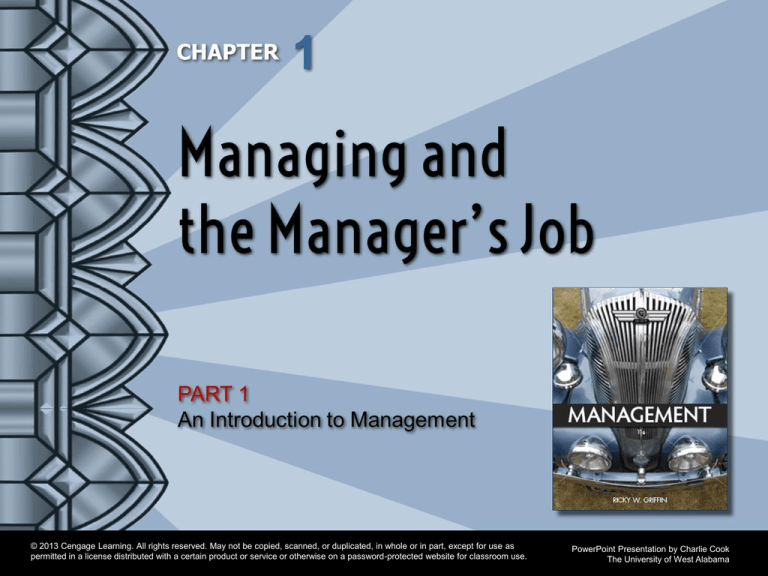
© 2013 Cengage Learning. All rights reserved. May not be copied, scanned, or duplicated, in whole or in part, except for use as
permitted in a license distributed with a certain product or service or otherwise on a password-protected website for classroom use.
PowerPoint Presentation by Charlie Cook
The University of West Alabama
Learning Objectives
1. Describe the nature of management, define management and
managers, and characterize their importance to contemporary
organizations.
2. Identify and briefly explain the four basic management functions in
organizations.
3. Describe the kinds of managers found at different levels and in
different areas of the organization.
4. Identify the basic managerial roles that managers play and the skills
they need to be successful.
5. Discuss the science and the art of management, describe how
people become managers, and summarize the scope of
management in organizations.
6. Characterize the new workplace that is emerging in organizations
today.
© 2013 Cengage Learning. All rights reserved. May not be copied, scanned, or duplicated, in whole or in part, except for use as
permitted in a license distributed with a certain product or service or otherwise on a password-protected website for classroom use.
1–2
What Is an Organization?
• A group of people working together
in a structured and coordinated
fashion to achieve a set of goals.
© 2013 Cengage Learning. All rights reserved. May not be copied, scanned, or duplicated, in whole or in part, except for use as
permitted in a license distributed with a certain product or service or otherwise on a password-protected website for classroom use.
1–3
Types of Organizational Resources
Organizational
Resources
Physical
Resources
Human
Resources
Information
Resources
© 2013 Cengage Learning. All rights reserved. May not be copied, scanned, or duplicated, in whole or in part, except for use as
permitted in a license distributed with a certain product or service or otherwise on a password-protected website for classroom use.
Financial
Resources
1–4
Organizational Resources
• Human resources
Managerial talent and labor
• Financial resources
Capital investments to support
ongoing and long-term operations
• Physical resources
Raw materials; office and production
facilities, and equipment
• Information resources
Usable data, information linkages
© 2013 Cengage Learning. All rights reserved. May not be copied, scanned, or duplicated, in whole or in part, except for use as
permitted in a license distributed with a certain product or service or otherwise on a password-protected website for classroom use.
1–5
1.1 Examples of Resources Used by Organizations
Human
Resources
Financial
Resources
Physical
Resources
Information
Resources
Royal Dutch/
Shell Group
Drilling
platform
workers
Corporate
executives
Profits
Stockholder
investments
Refineries
Office buildings
Sales forecasts
OPEC
proclamations
Michigan State
University
Faculty
Administrative
staff
Alumni
contributions
Government
grants
Computers
Campus facilities
Research reports
Government
publications
New York City
Police officers
Municipal
employees
Tax revenue
Government
grants
Sanitation
equipment
Municipal
buildings
Economic
forecasts
Crime statistics
Susan’s Corner
Grocery Store
Grocery clerks
Bookkeeper
Profits
Owner
investment
Building
Display shelving
Price lists from
suppliers
Newspaper ads
for competitors
Organization
© 2013 Cengage Learning. All rights reserved. May not be copied, scanned, or duplicated, in whole or in part, except for use as
permitted in a license distributed with a certain product or service or otherwise on a password-protected website for classroom use.
1–6
What is Management?
• A set of activities
planning and decision making, organizing,
leading, and controlling
directed at an organization’s resources
human, financial, physical, and information
with the aim of achieving organizational goals
in an efficient and effective manner.
© 2013 Cengage Learning. All rights reserved. May not be copied, scanned, or duplicated, in whole or in part, except for use as
permitted in a license distributed with a certain product or service or otherwise on a password-protected website for classroom use.
1–7
1.1 Management in Organizations
© 2013 Cengage Learning. All rights reserved. May not be copied, scanned, or duplicated, in whole or in part, except for use as
permitted in a license distributed with a certain product or service or otherwise on a password-protected website for classroom use.
1–8
The Basic Purpose of Management
EFFICIENTLY
Using resources wisely and in
a cost-effective way
And
EFFECTIVELY
Making the right decisions and
successfully implementing them
© 2013 Cengage Learning. All rights reserved. May not be copied, scanned, or duplicated, in whole or in part, except for use as
permitted in a license distributed with a certain product or service or otherwise on a password-protected website for classroom use.
1–9
What is a Manager?
• Someone whose primary responsibility is to carry
out the management process.
Plans and makes decisions, organizes, leads, and
controls human, financial, physical, and information
resources.
© 2013 Cengage Learning. All rights reserved. May not be copied, scanned, or duplicated, in whole or in part, except for use as
permitted in a license distributed with a certain product or service or otherwise on a password-protected website for classroom use.
1–10
The Manager’s Job
• Plan:
A manager cannot operate effectively unless he or
she has long range plans.
• Organize
When there is more than one employee needed to
carry out a plan, then organization is needed.
• Control
Develop a method to know how well employees are
performing to determine what has been and what still
must be done.
© 2013 Cengage Learning. All rights reserved. May not be copied, scanned, or duplicated, in whole or in part, except for use as
permitted in a license distributed with a certain product or service or otherwise on a password-protected website for classroom use.
1–11
1.2 The Management Process
© 2013 Cengage Learning. All rights reserved. May not be copied, scanned, or duplicated, in whole or in part, except for use as
permitted in a license distributed with a certain product or service or otherwise on a password-protected website for classroom use.
1–12
The Management Process
• Planning and Decision Making:
Determining goals and courses of action
• Organizing:
Coordinating activities and resources
• Leading:
Motivating and managing people
• Controlling:
Monitoring and evaluating activities
© 2013 Cengage Learning. All rights reserved. May not be copied, scanned, or duplicated, in whole or in part, except for use as
permitted in a license distributed with a certain product or service or otherwise on a password-protected website for classroom use.
1–13
1.3 Kinds of Managers by Level and Area
© 2013 Cengage Learning. All rights reserved. May not be copied, scanned, or duplicated, in whole or in part, except for use as
permitted in a license distributed with a certain product or service or otherwise on a password-protected website for classroom use.
1–14
Kinds of Managers by Level
• Top Managers
are the small group of executives who manage the
overall organization. They create the organization’s
goals, overall strategy, and operating policies.
• Middle Managers
are primarily responsible for implementing the policies
and plans of top managers. They also supervise and
coordinate the activities of lower level managers.
• First-Line Managers
supervise and coordinate the activities of operating
employees.
© 2013 Cengage Learning. All rights reserved. May not be copied, scanned, or duplicated, in whole or in part, except for use as
permitted in a license distributed with a certain product or service or otherwise on a password-protected website for classroom use.
1–15
Kinds of Managers by Area
Marketing
Managers
Financial
Managers
Human Resources
Managers
Kinds of
Managers
by Area
Operations
Managers
© 2013 Cengage Learning. All rights reserved. May not be copied, scanned, or duplicated, in whole or in part, except for use as
permitted in a license distributed with a certain product or service or otherwise on a password-protected website for classroom use.
Administrative
Managers
Specialist
Managers
1–16
Kinds of Managers by Area
• Marketing Managers
work in areas related to getting consumers and clients
to buy the organization’s products or services—new
product development, promotion, and distribution.
• Financial Managers
deal primarily with an organization’s financial
resources—accounting, cash management, and
investments.
• Operations Managers
are involved with systems that create products and
services—production control, inventory, quality
control, plant layout, site selection.
© 2013 Cengage Learning. All rights reserved. May not be copied, scanned, or duplicated, in whole or in part, except for use as
permitted in a license distributed with a certain product or service or otherwise on a password-protected website for classroom use.
1–17
Kinds of Managers by Area (cont’d)
• Human Resources Managers
are involved in human resource activities.
• Administrative Managers
are generalists familiar with all functional areas of
management and are not associated with any
particular management specialty.
• Other Kinds of Managers
hold specialized managerial positions (e.g., public
relations managers) directly related to the needs of
the organization.
© 2013 Cengage Learning. All rights reserved. May not be copied, scanned, or duplicated, in whole or in part, except for use as
permitted in a license distributed with a certain product or service or otherwise on a password-protected website for classroom use.
1–18
Basic Managerial Roles and Skills
• Regardless of level or area, all managers must
play certain roles and exhibit specific skills in
order to be successful.
• Managers:
Do certain things.
Meet certain needs.
Have certain responsibilities.
© 2013 Cengage Learning. All rights reserved. May not be copied, scanned, or duplicated, in whole or in part, except for use as
permitted in a license distributed with a certain product or service or otherwise on a password-protected website for classroom use.
1–19
Lights, Roll Camera, Manage !!!
Interpersonal
Roles
Informational
Roles
Managerial
Roles
Decisional
Roles
© 2013 Cengage Learning. All rights reserved. May not be copied, scanned, or duplicated, in whole or in part, except for use as
permitted in a license distributed with a certain product or service or otherwise on a password-protected website for classroom use.
1–20
Managerial Roles (Mintzberg)
• Interpersonal Roles
Figurehead, leader, and liaison roles involve dealing
with other people.
• Informational Roles
Monitor, disseminator, and spokesperson roles
involve the processing of information.
• Decisional Roles
Entrepreneur, disturbance handler, resource allocator,
and negotiator are managerial roles primarily related
to making decisions.
© 2013 Cengage Learning. All rights reserved. May not be copied, scanned, or duplicated, in whole or in part, except for use as
permitted in a license distributed with a certain product or service or otherwise on a password-protected website for classroom use.
1–21
1.2 Ten Basic Managerial Roles
Category
Role
Sample Activities
Interpersonal
Figurehead
Attending ribbon-cutting ceremony for new plant
Leader
Encouraging employees to improve productivity
Liaison
Coordinating activities of two project groups
Monitor
Scanning industry reports to stay abreast of
developments
Disseminator
Sending memos outlining new organizational initiatives
Spokesperson
Making a speech to discuss growth plans
Entrepreneur
Developing new ideas for innovation
Disturbance
handler
Resolving conflict between two subordinates
Resource
allocator
Reviewing and revising budget requests
Negotiator
Reaching agreement with a key supplier or labor union
Informational
Decisional
© 2013 Cengage Learning. All rights reserved. May not be copied, scanned, or duplicated, in whole or in part, except for use as
permitted in a license distributed with a certain product or service or otherwise on a password-protected website for classroom use.
1–22
What Skills Do Managers Need?
Technical
Conceptual
Interpersonal
Fundamental
Management
Skills
Diagnostic
Decision
Making
Communication
Time
Management
© 2013 Cengage Learning. All rights reserved. May not be copied, scanned, or duplicated, in whole or in part, except for use as
permitted in a license distributed with a certain product or service or otherwise on a password-protected website for classroom use.
1–23
Managerial Skills
• Technical
To accomplish or understand the specific kind of work
being done in an organization.
• Interpersonal
To communicate with, understand, and motivate both
individuals and groups.
• Conceptual
To think in the abstract.
• Diagnostic
To visualize the appropriate response to a situation.
© 2013 Cengage Learning. All rights reserved. May not be copied, scanned, or duplicated, in whole or in part, except for use as
permitted in a license distributed with a certain product or service or otherwise on a password-protected website for classroom use.
1–24
Managerial Skills (cont’d)
• Communication
To convey ideas and information effectively to others
and to receive the same effectively from others.
• Decision-Making
To recognize and define problems and opportunities
and then to select an appropriate course of action to
solve problems and capitalize on opportunities.
• Time-Management
To prioritize work, to work efficiently, and to delegate
appropriately.
© 2013 Cengage Learning. All rights reserved. May not be copied, scanned, or duplicated, in whole or in part, except for use as
permitted in a license distributed with a certain product or service or otherwise on a password-protected website for classroom use.
1–25
Management: Science or Art?
• The Science of Management
Assumes that problems can be approached using rational,
logical, objective, and systematic ways.
Requires the use of technical, diagnostic, and decision-making
skills and techniques to solve problems.
• The Art of Management
Making decisions and solving problems using a blend of intuition,
experience, instinct, and personal insights.
Using conceptual, communication, interpersonal, and time-
management skills to accomplish the tasks associated with
managerial activities.
© 2013 Cengage Learning. All rights reserved. May not be copied, scanned, or duplicated, in whole or in part, except for use as
permitted in a license distributed with a certain product or service or otherwise on a password-protected website for classroom use.
1–26
Management Challenge Question
• What do you say to your boss when your boss
wants you to make the numbers fit the
forecast?
A. What do you want the numbers to be?
B. Which numbers are right? which are wrong?
C. No problem. If anyone asks, I’ll say that I deferred
to your judgment and am using your numbers.
D. What are the consequences if I refuse to do that?
© 2013 Cengage Learning. All rights reserved. May not be copied, scanned, or duplicated, in whole or in part, except for use as
permitted in a license distributed with a certain product or service or otherwise on a password-protected website for classroom use.
1–27
1.4 Sources of Management Skills
© 2013 Cengage Learning. All rights reserved. May not be copied, scanned, or duplicated, in whole or in part, except for use as
permitted in a license distributed with a certain product or service or otherwise on a password-protected website for classroom use.
1–28
The Scope of Management
• For-Profit Organizations
Large businesses
Industrial firms, commercial banks, insurance firms, retailers,
transportation firms, utilities, communication firms, service
organizations
Small businesses and start-up businesses
International management
• Not-for-Profit Organizations
Governmental organizations—local, state, and federal
Educational organizations—public and private schools, colleges,
and universities
Healthcare facilities—public hospitals and HMOs
Nontraditional settings—community, social, spiritual groups
© 2013 Cengage Learning. All rights reserved. May not be copied, scanned, or duplicated, in whole or in part, except for use as
permitted in a license distributed with a certain product or service or otherwise on a password-protected website for classroom use.
1–29
You’re the Manager
• The Situation:
The group manager that you replacing has remained on job for a
short time to train you, however he did not actively involve you in
daily operations. He departs permanently after today’s meeting.
Morale is low because the group manager has been running a
one-person show with no significant delegation or participation by
other employees.
The overall performance of the group appears to be far below its
current capabilities.
• What will you do first?
• After that, what will you do next?
© 2013 Cengage Learning. All rights reserved. May not be copied, scanned, or duplicated, in whole or in part, except for use as
permitted in a license distributed with a certain product or service or otherwise on a password-protected website for classroom use.
1–30
•
•
•
•
•
•
•
•
•
•
•
organization
management
effective
efficient
manager
decision making
organizing
leading
controlling
levels of management
areas of management
•
•
•
•
•
•
•
•
•
•
interpersonal roles
informational roles
decisional roles
technical skills
interpersonal skills
conceptual skills
diagnostic skills
communication skills
decision-making skills
time-management skills
© 2013 Cengage Learning. All rights reserved. May not be copied, scanned, or duplicated, in whole or in part, except for use as
permitted in a license distributed with a certain product or service or otherwise on a password-protected website for classroom use.
1–31

